Related Research Articles
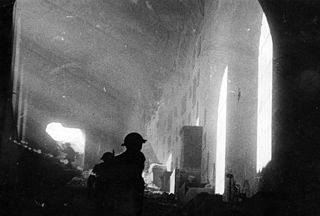
The Battle of Monte Cassino, also known as the Battle for Rome, was a series of four military assaults by the Allies against German forces in Italy during the Italian Campaign of World War II. The objective was to break through the Winter Line and facilitate an advance towards Rome.

The Battle of Anzio was a battle of the Italian Campaign of World War II that commenced January 22, 1944. The battle began with the Allied amphibious landing known as Operation Shingle, and ended on June 4, 1944, with the liberation of Rome. The operation was opposed by German and by Italian Repubblica Sociale Italiana (RSI) forces in the area of Anzio and Nettuno.
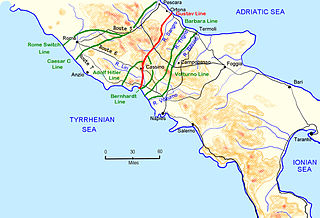
The Winter Line was a series of German and Italian military fortifications in Italy, constructed during World War II by Organisation Todt and commanded by Albert Kesselring. The series of three lines was designed to defend a western section of Italy, focused around the town of Monte Cassino, through which ran the important Highway 6 which led uninterrupted to Rome. The primary Gustav Line ran across Italy from just north of where the Garigliano River flows into the Tyrrhenian Sea in the west, through the Apennine Mountains to the mouth of the Sangro River on the Adriatic coast in the east. The two subsidiary lines, the Bernhardt Line and the Hitler Line, ran much shorter distances from the Tyrrehnian Sea to just northeast of Cassino where they would merge into the Gustav Line. Relative to the Gustav Line, the Hitler Line stood to the northwest and the Bernhardt Line to the southeast of the primary defenses.
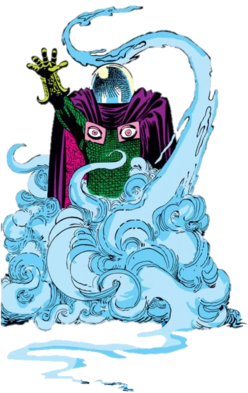
Mysterio is a supervillain appearing in American comic books published by Marvel Comics. Created by Stan Lee and Steve Ditko, the character first appeared in The Amazing Spider-Man #13. In his comic book appearances, Mysterio is the alias of Quentin Beck, a former special effects artist, illusionist and actor who turns to crime. He is one of the superhero Spider-Man's most enduring enemies and belongs to the collective of adversaries that make up his rogues gallery. He is also a founding member of the supervillain team the Sinister Six, and has fought other heroes, including Daredevil.
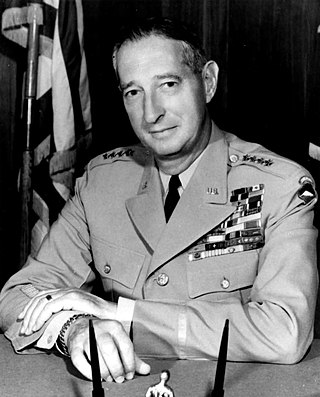
Mark Wayne Clark was a United States Army officer who saw service during World War I, World War II, and the Korean War. He was the youngest four-star general in the US Army during World War II.

The Allied Armies in Italy (AAI) was the title of the highest Allied field headquarters in Italy, during the middle part of the Italian campaign of World War II. In the early and later stages of the campaign the headquarters was known as the 15th Army Group; it reported to the Joint Allied command Allied Forces Headquarters (AFHQ), the theatre command for the Mediterranean theatre.

The 2nd New Zealand Division, initially the New Zealand Division, was an infantry division of the New Zealand Military Forces during the Second World War. The division was commanded for most of its existence by Lieutenant-General Bernard C. Freyberg. It fought in Greece, Crete, the Western Desert and Italy. In the Western Desert Campaign, the division played a prominent role in the defeat of German and Italian forces in the Second Battle of El Alamein and the British Eighth Army's advance to Tunisia.

The Italian campaign of World War II, also called the Liberation of Italy following the German occupation in September 1943, consisted of Allied and Axis operations in and around Italy, from 1943 to 1945. The joint Allied Forces Headquarters (AFHQ) was operationally responsible for all Allied land forces in the Mediterranean theatre and it planned and led the invasion of Sicily in July 1943, followed in September by the invasion of the Italian mainland and the campaign in Italy until the surrender of the Axis forces in Italy in May 1945.

Samuel Michael "Sam" Fuller was an American film director, screenwriter, novelist, journalist, actor, and World War II veteran known for directing low-budget genre movies with controversial themes, often made outside the conventional studio system. Fuller wrote his first screenplay for Hats Off in 1936, and made his directorial debut with the Western I Shot Jesse James (1949). He would continue to direct several other Westerns and war thrillers throughout the 1950s.

The 90th Light Infantry Division was a light infantry division of the German Army during World War II that served in North Africa as well as Sardinia and Italy. The division played a major role in most of the actions against the British Eighth Army in the Western Desert Campaign and eventually surrendered to the Allies in the final stages of the Tunisia Campaign in May 1943. It was re-constituted later in 1943 and deployed to Sardinia and when the expected Allied invasion of Sardinia failed to materialise, the division was moved to Italy. It was engaged in actions against the Allies in Italy from 1943 to April 1945 when the division was listed as "destroyed" in the Po River valley.

Paramount News was a newsreel series that was produced by Paramount Pictures from 1927 to 1957.

Desert Victory is a 1943 film produced by the British Ministry of Information, documenting the Allies' North African campaign against Field Marshal Erwin Rommel and the Afrika Korps. This documentary traces the struggle between General Erwin Rommel and Field Marshal Bernard Montgomery, from German and Italian defeats at El Alamein to Tripoli. The film was produced by David MacDonald and directed by Roy Boulting who also directed Tunisian Victory and Burma Victory. Like the famous "Why We Fight" series of films by Frank Capra, Desert Victory relies heavily on captured German newsreel footage. Many of the most famous sequences in the film have been excerpted and appear with frequency in History Channel and A&E productions. The film won a special Oscar in 1943 and the 1951 film The Desert Fox: The Story of Rommel took sections of the film for its battle footage.

All the Young Men is a 1960 American Korean War feature film directed by Hall Bartlett and starring Alan Ladd and Sidney Poitier dealing with desegregation in the United States Marine Corps. Poitier plays a sergeant unexpectedly placed in command of the survivors of a platoon in the Korean War. The film explores the racial integration of the American military, centering on the African-American sergeant's struggle to win the trust and respect of the men in his unit.

The Spring 1945 offensive in Italy, codenamed Operation Grapeshot, was the final Allied attack during the Italian Campaign in the final stages of the Second World War. The attack in the Lombard Plain by the 15th Allied Army Group started on 6 April 1945 and ended on 2 May with the surrender of all Axis forces in Italy.

The United States Army North (ARNORTH) is a formation of the United States Army. An Army Service Component Command (ASCC) subordinate to United States Northern Command (NORTHCOM), ARNORTH is the joint force land component of NORTHCOM. ARNORTH is responsible for homeland defense and defense support of civil authorities. ARNORTH is headquartered at Fort Sam Houston, Texas. Redesignated ARNORTH in 2004, it was first activated in early January 1943 as the United States Fifth Army, under the command of Lieutenant General Mark W. Clark.
David McWilliams Ludlum was an American historian, meteorologist, entrepreneur, and author. He was the founder of the only magazine in the U.S. about weather, Weatherwise, founded in 1947.
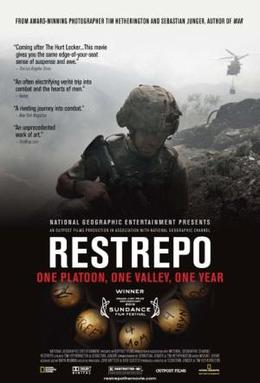
Restrepo is a 2010 American documentary film about the War in Afghanistan directed by British photojournalist Tim Hetherington and American journalist Sebastian Junger. It explores the year that Junger and Hetherington spent, on assignment for Vanity Fair, in Afghanistan's Korengal Valley, embedded with the Second Platoon, B Company, 2nd Battalion, 503rd Infantry Regiment, 173rd Airborne Brigade Combat Team of the U.S. Army. The Second Platoon is depicted defending the outpost (OP) named after a platoon medic who was killed earlier in the campaign, PFC Juan Sebastián Restrepo, who was a Colombian-born naturalized U.S. citizen. The directors stated that the film is not a war advocacy documentary, they simply "wanted to capture the reality of the soldiers."

Many films, books, and other media have depicted the 1950—53 Korean War. The TV series M*A*S*H is one well known example. The 1959 novel The Manchurian Candidate has twice been made into films. The 1982 film Inchon about the historic battle that occurred there in September 1950 was a financial and critical failure. By 2000 Hollywood alone had produced 91 feature films on the Korean War. Many films have also been produced in South Korea and other countries as well.

Eagle Squadron is a 1942 American war film directed by Arthur Lubin and starring Robert Stack, Diana Barrymore, John Loder and Nigel Bruce. It was based on a story by C.S. Forester that appeared in Cosmopolitan magazine, and inspired by media reports of the fighting in the Battle of Britain, in particular, the American pilots who volunteered before the United States entered World War II, to fly for the Royal Air Force in the actual Eagle Squadrons.

The Army Film and Photographic Unit was a subdivision of the British armed forces set up on 24 October 1941, to record military events in which the British and Commonwealth armies were engaged. During the war, almost 23 percent of all AFPU soldiers were killed in action; the AFPU was disbanded in 1946.
References
- ↑ Crowther, Bosley (4 October 1950). "Paramount's Documentary Film, 'Cassino to Korea,' Begins Run at Embassy Broadway Theatre". The New York Times. Archived from the original on May 19, 2015. Retrieved 10 May 2015.
- ↑ "'Cassino to Korea' Salutes Fighting American Soldiers". Ellensburg Daily Record. Washington: Clifford Kaynor. p. 4. Retrieved 10 May 2015.